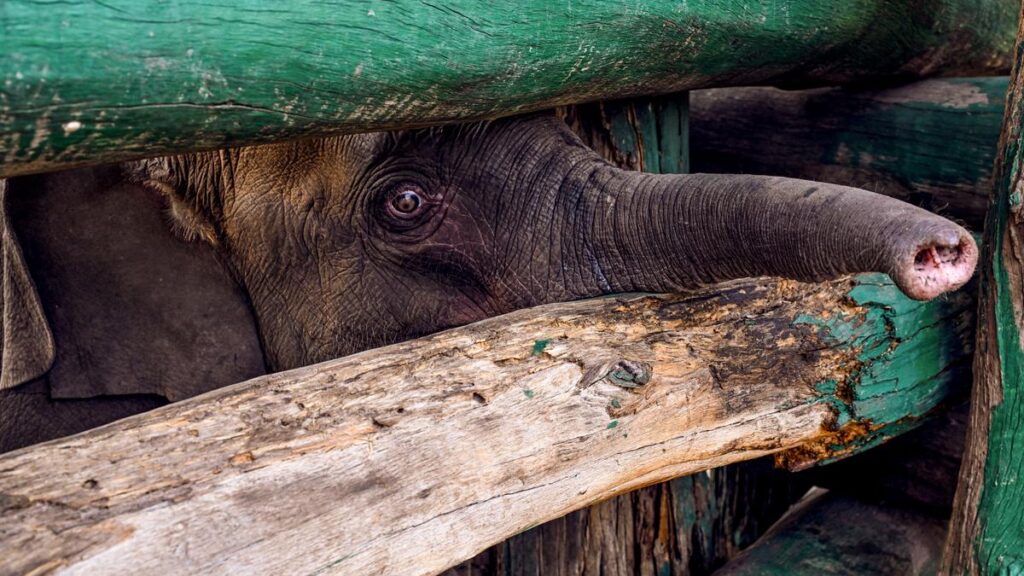
It was business as usual at the Bandhavgarh Tiger Reserve (BTR) in Madhya Pradesh on the morning of October 29. All the officers were headed to the BTR headquarters at Umaria for a review meeting. Some had already gone home for Diwali, while some were to leave in the next two days.
Arpit Mairal, the forest range officer of Pataur range, was running late for the meeting. On his way, at around 11 a.m., he got a call from the beat guard of Salkhaniya village, who told him that a herd of 13 wild elephants was behaving strangely.
“The guards and the beat officer had spotted the elephants some 200 metres away. They told me that four of them were lying on the ground and not moving, while some were sitting or standing in unusual positions,” says Mairal. Elephants do not usually lie down or sit for long as they find it difficult to get back on their feet.
Mairal immediately drove for an hour and a half to the spot on the border of the Pataur and Khitauli core ranges near Salkhaniya. He and some guards found 10 elephants lying on the forest floor in a radius of 100-150 m.
Mairal called the Bandhavgarh Deputy Director, Prakash Kumar Verma. He asked Verma to cancel the meeting and rush to the spot with all the rangers and sub-divisional officers (SDOs).
“Four elephants were dead. Six were barely moving — they were flapping their ears or moving their tails slowly,” he recalls, as he prepares a detailed report sought by the Union Ministry of Environment, Forest and Climate Change.
Mairal says Verma despatched all the officials to the spot and stayed back at the headquarters to call veterinarians from other national parks and from Umaria. BTR’s lone wildlife vet, Dr. Nitin Gupta, who was on his way to Jabalpur for personal reasons, rushed back to the reserve.
By 5 p.m., there were 150-200 guards, rangers, senior officials, and private and government vets, apart from a few heavy machines, tractors, and medical equipment at the spot. When it became dark, the two halogen lights installed for treatment proved insufficient. The officials positioned 10-12 cars in a half circle and used the vehicle lights. They also made small trenches and lit a fire to keep away other wild elephants.
For the next 36 hours, the spot turned into a makeshift hospital. However, despite their best efforts, four elephants died on October 30 and the remaining two passed away the next day. A post-mortem was conducted at the same spot and the pachyderms were buried nearby. During the burial, other elephants turned up, stood at a distance, trumpeted, and flapped their ears.
A crop that can kill
The death of the 10 elephants — nine female and one male — brought the BTR into the national limelight. Multiple teams of Central and State agencies visited the reserve for investigation. Chief Minister Mohan Yadav sent a three-member high-level team to Bandhavgarh. The State government suspended the Chief Conservator of Forests and Field Director as well as an SDO for negligence. Earlier this week, the Central government sent the Director General of Forests and Special Secretary in the Environment Ministry to Bhopal to report on the incident and the measures taken on elephant management.
The post-mortem report stated that the elephants died after eating Kodo millet. Forensic examinations confirmed this. A toxicology report from the Indian Council of Agricultural Research’s Indian Veterinary Research Institute (IVRI), Bareilly, said that a high concentration of cyclopiazonic acid was detected in multiple organs of each elephant and that the animals might have consumed a large quantity of Kodo plant/grains. A report from the School of Wildlife Forensic And Health (SWFH), Jabalpur, found acute toxicity in the vital organs of the animals. The BTR management also sent samples of Kodo crop and seeds to the International Crops Research Institute for the Semi-arid Tropics, Hyderabad, which found extremely high contents of cyclopiazonic acid in the crop samples, a source says.
Meanwhile, test results from the State Forensic Science Laboratory, Sagar, ruled out poisoning from pesticide, insecticide, or any other chemical. Allegations that the jumbos were killed by poachers were also found to be baseless.
On November 12, the National Green Tribunal issued notices to the Union Ministry of Agriculture and Farmers Welfare; the Wildlife Institute of India; IVRI, Bareilly; the Principal Chief Conservator of Forests and Chief Wildlife Warden, Madhya Pradesh; and the Umaria Collector into the deaths of the animals and the connection with Kodo.
An elephant being treated by veterinarians. It died along with nine others. Photo: Special Arrangement
Days after the 10 elephants died, a wild elephant killed two men and critically injured one. This led to concerns about a serious man-animal conflict in the region. Officials at BTR suspect, based on the description of the elephant and the location of the two deaths, that a male elephant, aged 10-12 years, captured after the killings, is from the same herd of 13. While another fully grown adult male remains untraced, a six-month-old calf of the herd was rescued in a distressed condition about a week later in Katni, about 80 km from the spot where the rest died. It is now at BTR’s Rama Elephant Camp.
A perfect storm
Known as a ‘wild cereal’, Kodo has been grown in India for centuries, but was largely limited to forests and tribal regions. As it is high in protein and fibre, Kodo has now become popular among people with lifestyle diseases. Kodo, once sold for about ₹40-50 per kilogramme in local farmers’ markets in Madhya Pradesh, is now priced at ₹90-120 per kg.

Bandhavgarh Deputy Director Verma says Kodo used to be grown on small patches of land. Now, farmers have started cultivating it on a large scale for commercial purposes.
The farm where the elephants ate Kodo belonged to Manoj Kumar from Salkhaniya. Verma says Kumar and two or three other farmers had grown Kodo in about 10 acres of land that was on the boundary of the core zone and the village.
Dr. A.B. Shrivastava, founder-director of SWFH, Jabalpur, who has been roped in to help at BTR, says symptoms of Kodo toxicity can be easily detected and treatment given for both animals and people. But in BTR, symptoms could not be detected and help provided in time because the animals were in the wild. They had eaten nearly 8 acres of Kodo, say officials.
Dr. Shrivastava highlights the need for a study on the health impacts of Kodo so that there is a designed treatment in place. “Right now, we only give treatment to animals based on the symptoms they display. Treatment includes fluid therapy with IV drips and other fluids to dilute Kodo, as well as multivitamins,” he says.
Kodo millet crop bundles that were burnt by forest officials after the death of 10 elephants.
| Photo Credit:
A.M. Faruqui
There is also limited research available on Kodo and more specifically, its relation with elephants. A 1983 research paper says, “Farmers believe that Kodo millet is poisonous after rain. It is known to produce unconsciousness or delirium with violent tremors of the voluntary muscles. There are reports that elephants have died from eating Kodo millet…”
A 2023 research paper titled Potential Risk of Cyclopiazonic Acid Toxicity in Kodua Poisoning, says, “Although millet is cultivated in dry and semi-arid regions, sometimes environmental conditions like spring and summer strike as being suitable for a certain kind of poisoning which leads to greater economic crop loss.” It adds that such conditions make millets more susceptible to fungal infections, especially from ergot fungi. The infection produces cyclopiazonic acid.
Dr. Shrivastava explains that such climatic conditions are rare, but are mostly seen in October when the sun is bright, the crop is ready for harvesting, and the region receives heavy rainfall. In the BTR case, high contents of fungus were also found in the harvested crop that was kept in bundles in the farm where the elephants ate.
A struggle in the wild
The eastern forests of Madhya Pradesh have always had elephants as visitors. In November 2018, a batch of 41 elephants arrived at BTR from Chhattisgarh and stayed. Within a year, they bred two calves. Since then, three forests in Madhya Pradesh — BTR, the Sanjay Dubri National Park in Sidhi, and the Kanha National Park in Mandla — have received multiple batches of elephants, mainly from Chhattisgarh and Odisha. The estimated jumbo population is 150. Bandhavgarh alone is home to 65-70 elephants, Mairal says.
But the State does not have the resources to deal with this increasing population. Forest guards, tasked with tracking the movements of animals such as tigers and elephants, are not provided with tranquillisers or vehicles to protect themselves in case of an attack. Gyaan Singh, a forest guard, survived an attack by a tiger in 2014. “The animal left me alive simply because it wanted to. I had no way of saving myself,” he says.
Chhullu Singh, a fellow guard posted closest to the spot where the 10 elephants died, carries an axe and rides a bicycle. He says the door and the windows of their quarters were broken by an elephant three years ago. “I wrote to senior officials many times but nothing has happened,” he says.
Verma says the department started building elephant-proof trenches around these quarters last year but is yet to cover all of them.
The tragedies show various other lapses on the part of the BTR management and at the policy level. “We don’t have a training team to work with wild elephants, especially orphans, when we rescue them,” says Verma. “We don’t know how to rehabilitate them. We need special enclosures to keep elephants which come away from their herd. We also need them to treat elephants that get hurt.” These facilities are available in Chhattisgarh. Talks are on with the Madhya Pradesh government to work on these aspects, he says.
Forest guards and beat guards of the Bandhavgarh Tiger Reserve carry out patrolling duties near the spot where 10 elephants died in October.
| Photo Credit:
A.M. Faruqui
The State government is also sending officials to Tamil Nadu and Karnataka, which have large elephant populations. They are expected to gain exposure on best practices on elephant management. The first batch is leaving on Sunday (November 17, 2024).
The government plans to use satellite collars on one or two members of a herd to track movements. Verma says a proposal to use thermal imaging to locate the animals easily is also being discussed. Another official at BTR says this can also be used to alert villagers about the movements of elephants. If these measures work, the forest department can use trap cameras to identify individual elephants, Verma contends.
Officials also admit that one or two of the elephants could have been saved if another doctor had been available. Dr. Gupta, the only vet at Bandhavgarh, recalls the events of October 29-31 as being “extremely stressful”.
“I was running around giving instructions to all the other vets we had brought in. Local vets mostly deal with domestic animals and don’t have expertise in dealing with wild animals,” he says. “It is difficult to give an injection or a drip to an elephant as it keeps moving and could hurt people. In such cases, we have to sometimes give liquid medicines through the animal’s rectum.”
Dr. Gupta says there is no permanent facility at BTR to treat animals and that he always travels to the spot to do his job. The new Field Director, Anupam Sahay, says the forest department is considering providing an assistant to Dr. Gupta, who has been with BTR for about 15 years.
Madhya Pradesh Additional Principal Chief Conservator of Forest-Wildlife, L. Krishnamoorty, says there is no separate budget for elephants in the State. Two years ago, Project Elephant was merged with Project Tiger in Madhya Pradesh. “As part of this, we get funding from both the Central and State governments,” he says.
‘They were family’
Meanwhile, locals are concerned that the man-animal conflict could become worse. Nine WhatsApp groups, one for each range of BTR, have suddenly become active. The groups have village heads, members of Hathi Mitra Dal (a designated group in each village to create awareness about elephants), local beat officers, rangers, and the Deputy Director as members. They receive messages every hour from people asking about elephant movements, and provide updates.
There is a tense silence in Salkhaniya village, about 1.5 km from the farm where elephants ate Kodo. Manoj Kumar’s house is locked.
A farmer, Rajpal Singh Gond, is one of the few who is willing to talk. “After the elephant deaths, the forest officials ploughed many fields where Kodo had been grown. Farmers were not even allowed to harvest and store the yield,” he says. “Nobody here will talk against the forest department as we have to rely on them for compensation in case of crop damage by animals.”
Sahay says Kodo had been cultivated in about 1,500 acres of land within the boundaries of BTR and more than half had been harvested. For the unharvested crop, farmers were given the option of handing over their yield to the forest department and getting compensated. Some agreed.
“Kodo in itself is not harmful, but at the moment we don’t have a way of identifying the fungal-infected crop. So, we considered all Kodo as harmful in the current circumstances,” he says.
Elsewhere, there is sorrow. Pushpendra Dwivedi, former honorary wildlife warden of Umaria, recalls the distress of other elephants during the post-mortem. “I think the 13 elephants were part of a larger herd of 32. They must have split up in search of food. When the others returned and saw the scenes during the post-mortem, they began to roar loudly. We had to use sirens and other noises to keep them away and continue the examination,” he says.
After the incident, patrolling teams have spotted smaller groups of elephants wandering in the forest. “We suspect that they are searching for their herd members. They generally end their search once they find evidence that their herd members are no more,” Mairal says.
Most officials say the three days were “traumatic and sad”. Brij Kishore Barman, a beat guard with Khitauli range, doubts if anyone celebrated Diwali. “You don’t celebrate festivals when someone in your family dies,” he says. “Here, we lost 10 of them.”
mehul.malpani@thehindu.co.in
Published – November 16, 2024 03:20 am IST
इसे शेयर करें:


